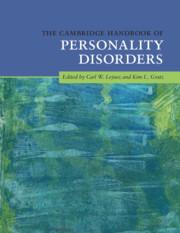Book contents
- The Cambridge Handbook of Personality Disorders
- The Cambridge Handbook of Personality Disorders
- Copyright page
- Contents
- Figures
- Tables
- Contributors
- Preface
- Part I Etiology
- Part II Models
- Part III Individual Disorders and Clusters
- Part IV Assessment
- 14 Methods and Current Issues in Dimensional Assessments of Personality Pathology
- 14a The Clinical Utility and Applications of Dimensional Assessments of Personality Pathology: Commentary on Methods and Current Issues in Dimensional Assessments of Personality Pathology
- 14b New and Continuing Developments in the Assessment of Personality Disorders: Commentary on Methods and Current Issues in Dimensional Assessments of Personality Pathology
- 14c The Importance of Multiple Sources, Longitudinal Assessment, and Clinical Utility: Author Rejoinder to Commentaries on Methods and Current Issues in Dimensional Assessments of Personality Pathology
- 15 Categorical Assessment of Personality Disorders: Considerations of Reliability and Validity
- 15a Categories, Constructs, and the Assessment of Personality Pathology: Commentary on Categorical Assessment of Personality Disorders
- 15b The Need for a More Rigorous Approach to Diagnostic Reliability: Commentary on Categorical Assessment of Personality Disorders
- 15c Balancing Hopeful and Pessimistic Views of the Future of Categorical Assessment: Author Rejoinder to Commentaries on Categorical Assessment of Personality Disorders
- 16 Assessment of Mechanisms in Personality Disorders
- 16a Parts, Wholes, and Explanations of Personality and Its Pathologies: Commentary on Assessment of Mechanisms in Personality Disorders
- 16b Genetic and Environmental Mechanisms in BPD over the Lifespan: Commentary on Assessment of Mechanisms in Personality Disorders
- 16c Complexity and Transactions: Author Rejoinder to Commentaries on Assessment of Mechanisms in Personality Disorders
- Part V Treatment
- Index
- References
15b - The Need for a More Rigorous Approach to Diagnostic Reliability: Commentary on Categorical Assessment of Personality Disorders
from Part IV - Assessment
Published online by Cambridge University Press: 24 February 2020
- The Cambridge Handbook of Personality Disorders
- The Cambridge Handbook of Personality Disorders
- Copyright page
- Contents
- Figures
- Tables
- Contributors
- Preface
- Part I Etiology
- Part II Models
- Part III Individual Disorders and Clusters
- Part IV Assessment
- 14 Methods and Current Issues in Dimensional Assessments of Personality Pathology
- 14a The Clinical Utility and Applications of Dimensional Assessments of Personality Pathology: Commentary on Methods and Current Issues in Dimensional Assessments of Personality Pathology
- 14b New and Continuing Developments in the Assessment of Personality Disorders: Commentary on Methods and Current Issues in Dimensional Assessments of Personality Pathology
- 14c The Importance of Multiple Sources, Longitudinal Assessment, and Clinical Utility: Author Rejoinder to Commentaries on Methods and Current Issues in Dimensional Assessments of Personality Pathology
- 15 Categorical Assessment of Personality Disorders: Considerations of Reliability and Validity
- 15a Categories, Constructs, and the Assessment of Personality Pathology: Commentary on Categorical Assessment of Personality Disorders
- 15b The Need for a More Rigorous Approach to Diagnostic Reliability: Commentary on Categorical Assessment of Personality Disorders
- 15c Balancing Hopeful and Pessimistic Views of the Future of Categorical Assessment: Author Rejoinder to Commentaries on Categorical Assessment of Personality Disorders
- 16 Assessment of Mechanisms in Personality Disorders
- 16a Parts, Wholes, and Explanations of Personality and Its Pathologies: Commentary on Assessment of Mechanisms in Personality Disorders
- 16b Genetic and Environmental Mechanisms in BPD over the Lifespan: Commentary on Assessment of Mechanisms in Personality Disorders
- 16c Complexity and Transactions: Author Rejoinder to Commentaries on Assessment of Mechanisms in Personality Disorders
- Part V Treatment
- Index
- References
Summary
Diagnostic reliability receives cursory attention in the literature with wide ranges of kappa coefficients often interpreted as “adequate.” Moreover, the vast majority of personality disorder (PD) kappa estimates, including those reviewed by Flory (this chapter), are derived from the audio/video recording method. This method results in inflated estimates of diagnostic reliability, which provides limited insight into whether patients would receive the same diagnosis at different hospitals or clinics and whether researchers are studying similar patients. A more rigorous and ecologically valid method for assessing diagnostic reliability is the test-retest method. Although echoing some of Flory’s points, the authors here disagree with her assertion that categorical PDs demonstrate acceptable reliability. In fact, the reliability of categorical PDs assessed using the test-retest method is far lower than the DSM-5 conceptualization would indicate. Moreover, the test-retest diagnostic reliability of categorical PDs fails to achieve minimal benchmarks established in the “normal” personality literature, indicating critical problems for the DSM-5 categorical model. If the goal is to provide optimal patient care and advance clinical science, then adopting the trait-based dimensional model of personality pathology from section III of DSM-5 is necessary.
- Type
- Chapter
- Information
- The Cambridge Handbook of Personality Disorders , pp. 369 - 372Publisher: Cambridge University PressPrint publication year: 2020

